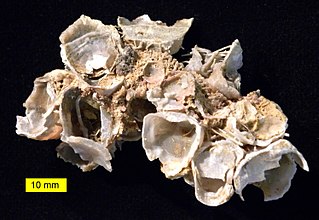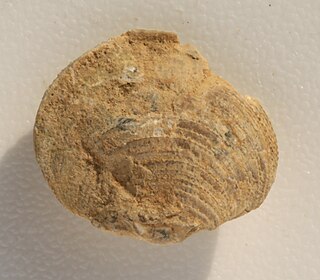Dolerorthis is an extinct genus of hesperorthid brachiopod. The type species of this genus, D. interplicata, was described from the Silurian (Telychian) Osgood Formation. Other species belonging to this genus are known from the Ordovician and Silurian of Europe, Kazakhstan, China and Argentina. It was roughly 4 centimetres (1.6 in) across.

Hercosestria is an extinct genus of brachiopods from the Lower and Middle Permian. They were important reef-forming organisms because of their conical shapes, attaching spines, and gregarious habits. It is related to Richthofenia. Species of the genus have been found in Texas and Guatemala.
Skenidioides is an extinct genus of brachiopods which existed during the Ordovician, Silurian, and Devonian of what is now Australia, Canada, China, the Czech Republic, Italy, Morocco, Poland, Ukraine, the United States, Belarus, Estonia, Lithuania, Mexico, Norway, Sweden, the United Kingdom, Venezuela, Ireland, Kazakhstan, the Russian Federation, and Argentina. It was described by Schuchert and Cooper in 1931, and the type species is S. billingsi. A new species, S. tatyanae, was described by Andrzej Baliński in 2012, from the early Devonian of Ukraine. The species epithet refers to Tatyana Lvovna Modzalevskaya.

Composita is an extinct brachiopod genus that lived from the Late Devonian to the Late Permian. Composita had a cosmopolitan global distribution, having lived on every continent except Antarctica. Composita had a smooth shell with a more or less distinct fold and sulcus and a round opening for the pedicle on the pedicle valve. Composita is included in the family Athyrididae and placed in the subfamily Spirigerellinae.

Sphenorhynchia plicatella is an extinct species of brachiopods belonging to the family Prionorhynchiidae.

Prionorhynchiidae is an extinct family of brachiopods belonging to the order Rhynchonellida.

Gypospirifer is an extinct genus of articulate brachiopod fossils belonging to the family Trigonotretidae. They were stationary epifaunal suspension feeders.

Cleiothyridina is an extinct genus of brachiopods.

Rafinesquina is an extinct genus of large brachiopod that existed from the Darriwilian to the Ludlow epoch.

Leptaena is an extinct genus of mid-sized brachiopod that existed from the Dariwilian epoch to the Emsian epoch, though some specimens have been found in strata as late in age as the Tournasian epoch. Like some other Strophomenids, Lepteana were epifaunal, meaning they lived on top of the seafloor, not buried within it, and were suspension feeders.
Basiliola is a genus of brachiopods belonging to the family Basiliolidae.
Tichosina is a genus of brachiopods belonging to the family Terebratulidae.
Jolonica is a genus of brachiopods belonging to the family Frenulinidae.
Dallithyris is a genus of brachiopods belonging to the family Terebratulidae.
Ecnomiosa is a genus of brachiopods belonging to the family Kingenidae.
Eucalathis is a genus of brachiopods belonging to the family Chlidonophoridae.
Lacazella is a genus of brachiopods belonging to the family Thecideidae.
Platidia is a genus of brachiopods belonging to the family Platidiidae.
Stenosarina is a genus of brachiopods belonging to the family Terebratulidae.
Crurithyris is an extinct genus of brachiopod belonging to the order Spiriferida and family Ambocoeliidae.







